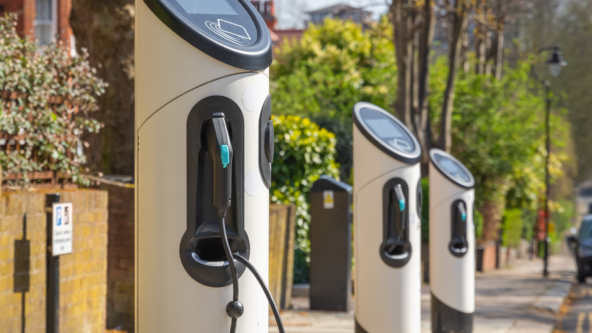London, 12 January 1882.
A column of thick smoke twists into the night sky. The steam turbine of one of the world’s first coal-fired power stations turns for the first time.
The lights go on.
A total of 968 electric lamps illuminate a half-mile stretch from Holborn Circus to St. Martin’s le Grand. Thomas Edison’s Holborn Viaduct Power Station is powering them.
The incandescent bulb has already existed for three years. But it’s only now that the electric light bulb is beginning to find its way into everyday life.
The technology is proven and there is ready-built demand. All that’s needed is forward-thinking engineers to build the infrastructure needed to realise the vision of an electrified UK.
Thomas Edison’s Holborn Viaduct Power Station helps lay a blueprint for a new era, where polluting oil lamps are replaced by the electric light bulb.
New infrastructure and the path to net zero
Today, a short walk from where the Holborn Viaduct Power Station once sat, are the offices of Octopus Capital.
Octopus is one of a handful of financial services companies playing a part in a different energy story. That story is not only about the advancement of technology and infrastructure, but about improving society and the planet.
While Edison helped the transition to electric, the energy generation underpinning this relied on burning fossil fuels.
Octopus has already had a significant role in scaling renewables into the mature sector it is today. We’re now turning our attention to the next generation of sustainable businesses.
Renewable energy investment has accelerated the UK transition away from fossil fuels. The UK renewables sector is now operating at scale. In 2019, green electricity production overtook fossil fuels in the UK, and in August of that year, renewables hit a record share of production at 85%.1
But to achieve the full extent of the UK’s net zero and levelling up ambitions, investment is needed in emerging infrastructure sectors, not just these established assets. Energy production is just one aspect of the green agenda. It’s now time to accelerate the growth of emerging infrastructure, where there is established technology and pent-up demand.
Thomas Edison brought power stations and the electric light bulb to the streets of London. Today there are countless opportunities for businesses to roll out new technologies across the UK. These new technologies will pave the way for a more sustainable future.
Investing in emerging sustainable infrastructure
You might not be familiar with the term emerging sustainable infrastructure. But it’s a relatively straightforward concept to understand. If you think about solar and wind assets, these are examples of sustainable infrastructure sectors that have grown into established and mature markets. They are seen as a reliable asset class for many institutional investors.
But there’s a new wave of sustainable infrastructure waiting to be rolled out across the UK. Technologies that are critical to achieving our climate objectives. These sectors are emerging, require investment, and offer attractive potential for returns because they are less mature.
Emerging sustainable infrastructure as a sector consists of companies with proven technologies that build assets which will become sustainable core infrastructure over the next decade. This is an area that should excite investors, as there is minimal technology risk and no need to create a new market. The focus is firmly on scaling up a sector that already has everything in place to be a success.
Opportunities range from electric vehicle infrastructure and clean fuels, to long-duration energy storage assets and from energy-efficient data centres, to recycling. All these growing areas will be crucial for the UK in its effort to achieve a net-zero economy by 2050.
The investment opportunity
Until these emerging infrastructure sectors have reached sufficient scale and are operational for some time, larger and more traditional infrastructure funds and banks will feel unable to back these assets. At the same time, companies rolling out new infrastructure are often too capital-intensive and too established to be considered by venture capital funds. They are also not suitable for typical private equity mandates.
So the UK clearly needs infrastructure growth capital which can support emerging sustainable companies after they are proven and help them to scale.
The Octopus Sustainable Infrastructure team was formed to fill the funding gap that exists for the next generation of sustainable infrastructure companies. The team channels private capital into companies that are tackling climate change and which can support levelling-up ambitions across the UK.
“I started my career as a mechanical engineer at Arup focused on sustainability,” explains Lukasz Michalak, Investment Director. “I spent most of my time designing and building a future where natural resources aren’t depleted. That was nearly 20 years ago. Now I am excited to be using my engineering background to work alongside amazing management teams building the infrastructure of the future.”
“We want to invest in the infrastructure that will one day become core assets in portfolios. And we want to do that by backing the companies rolling out that infrastructure,”
“Rather than invest in infrastructure assets, we prefer backing platforms. These are the companies with expertise in building and operating a specific asset type. We realised that the combination of infrastructure characteristics and the scalability of a platform offers attractive potential for returns. So Octopus has spent the last ten years backing platforms in sectors such as energy, telecoms, and real estate. The ecosystem we have built within Octopus has compelling synergies for the new sustainable businesses we are working with today.”
Particular areas of focus for the team are future mobility (removing barriers to electric vehicle adoption), energy transition (speeding up the shift to a low-carbon energy system), digital infrastructure (improving energy efficiency data processing and transit), and the circular economy (increasing the reuse of resources).
1 How much of the UK’s energy is renewable?

Sustainable Infrastructure: Going Beyond Renewables

Unlocking the UK’s regional potential by building a new generation of sustainable infrastructure

